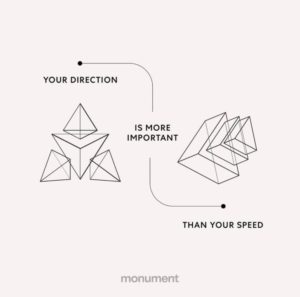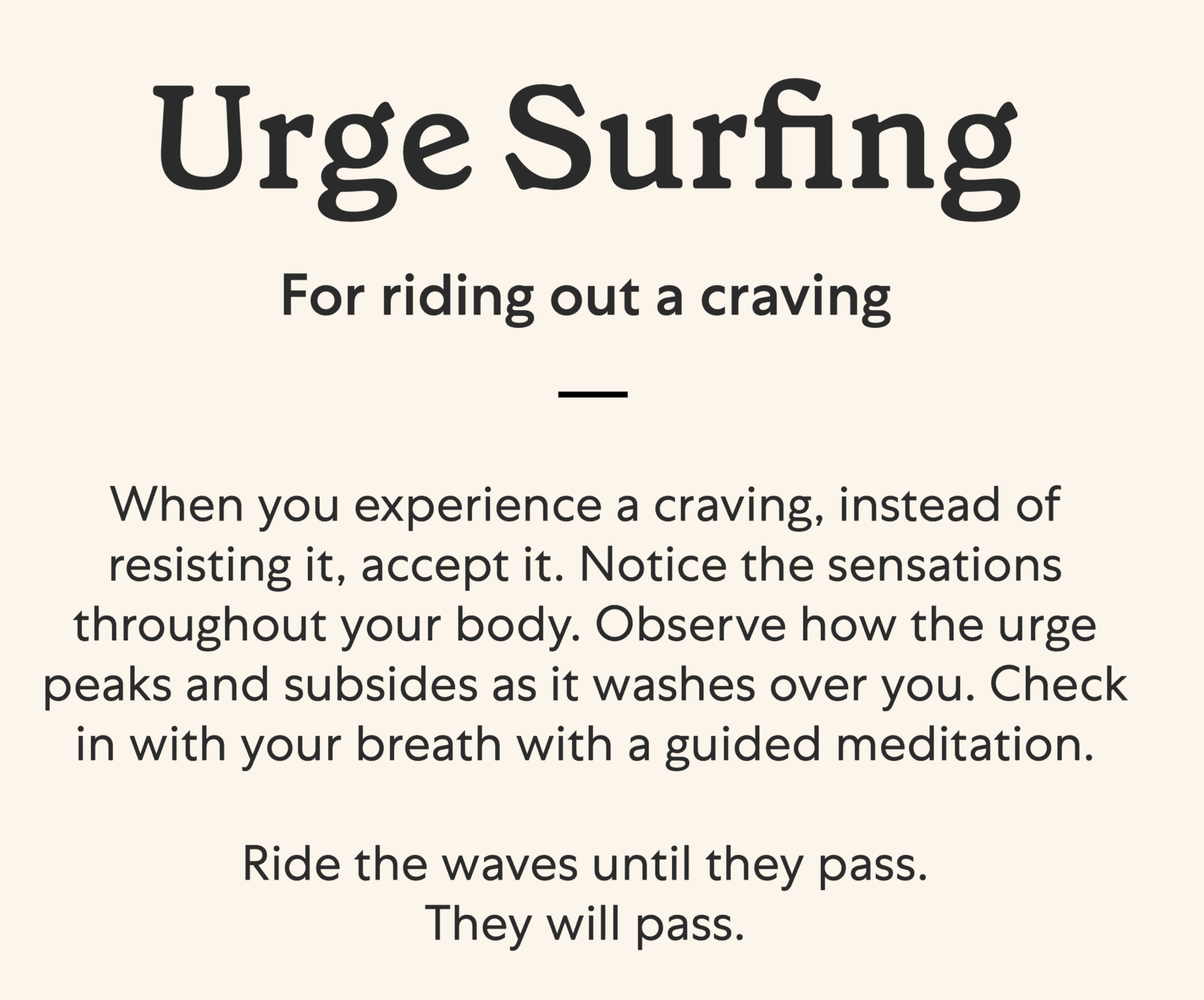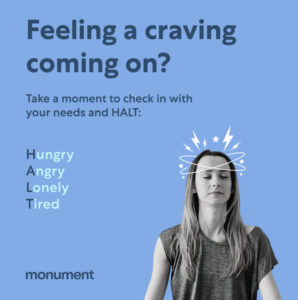The flushed feeling. The heart pounding. The intense visualization of your favorite drink. If you’ve had an alcohol craving before, these sensations may feel familiar to you. There is no shame in that. Alcohol cravings are a common and normal part of recovery. While they can be uncomfortable and challenging, they become less intense and easier to manage over time. As a physician on the Monument platform, it’s my goal to help my patients understand where cravings come from and how long they typically last. If safe and appropriate, we also discuss craving-suppressant medication to stop drinking. Let’s get into the details.
Where Do Alcohol Cravings Come From?
The two main causes of alcohol cravings can be explained by the incentive and tolerance models. In other words, wanting to feel good, and wanting to avoid negative consequences.
- The incentive model is when a person craves alcohol because they want to experience the positive effects of drinking, such as euphoria. The brain releases dopamine when consuming alcohol, causing a short-term euphoric sensation. After a period of extended alcohol use, the brain adapts to crave this feel-good boost of dopamine, and even just the thought of drinking can trigger a craving.
- The tolerance model is when a person in early recovery craves alcohol in order to not experience the negative effects of alcohol withdrawal, such as hangxiety, nausea, headaches, and personal consequences.
For most people, their cravings are a combination of these two reasons. Learning more about the science behind cravings can help you better understand your experience and what to expect in the alcohol recovery timeline.
Symptoms of Alcohol Cravings
Most individuals with alcohol use disorder experience cravings from time to time. Despite this common phenomenon, there isn’t one set definition of what a craving feels like. This is partly because cravings are experienced slightly differently for each individual. One way to define a craving is the sensation of a general ‘need’ for alcohol, in the same way one feels hunger before eating. This sensation can vary in intensity and can be characterized by withdrawal-like symptoms such as restlessness and nausea. A craving can be triggered by internal and external cues that serve as reminders of the euphoric effects of alcohol or the discomfort of alcohol withdrawal.
Stages of Alcohol Withdrawal
Cravings are considered a symptom of alcohol withdrawal. When an individual drinks heavily over an extended amount of time, their body and brain can become dependent on alcohol and see it as essential for survival. (This is the origin of the term ‘alcohol dependence’.) When alcohol is then removed from the equation, the body has a strong reaction. There are two general stages of alcohol withdrawal, each with varying degrees of severity:
Acute Alcohol Withdrawal
This form of withdrawal typically happens within the first week after you stop drinking. It’s characterized by symptoms such as cravings, sweating, fever, and more severe symptoms like hallucinations or seizures. These effects can be dangerous and even life-threatening. That’s why it’s vital you speak with a physician before you quit alcohol or cut back significantly to determine if supervised detox is necessary.
Post-acute Alcohol Withdrawal
Once the initial withdrawal response passes, it’s common to go through a longer-term withdrawal experience known as post-acute withdrawal syndrome, or PAWS. Some of the most common symptoms of PAWS include anxiousness, mood swings, disrupted sleep, and prolonged alcohol cravings. PAWS can continue for weeks or months into recovery, but does subside with time.
If you believe you might be experiencing acute alcohol withdrawal, please contact your healthcare provider immediately and visit https://findtreatment.gov/ to find a location to get supervised detox near you. If this is a medical emergency, call 911.

How Long Do Alcohol Cravings Last?
A singular intense craving for alcohol typically lasts between 3-5 minutes. These sudden urges to drink can arise frequently throughout the recovery journey. There’s no way to determine exactly how long an individual will continue to experience alcohol cravings, but we can look at common patterns to help give us an idea of what to expect. It’s important to remember that this experience is incredibly common, and that with time and practice cravings will become significantly more manageable.
The First Week Without Alcohol:
Cravings typically appear about 3 days after stopping alcohol consumption. The craving sensation is then likely to intensify by about 5 to 7 days after the last drink. This is also the time where other acute alcohol withdrawal symptoms may develop.
The Next 2-4 Weeks:
By the second week, alcohol cravings and urges may become more frequent and severe. The sudden and unpleasant urge to drink may continue to arise into the first four weeks of recovery. These cravings may be coupled with other post-acute withdrawal symptoms like anxiety and irritability, which can exacerbate cravings. This is an especially important time to engage in your recovery toolkit and reference resources such as tips for early sobriety.
After One Month of Sobriety:
After the first month without alcohol, cravings typically become less frequent and severe. When they do occur, they’re likely to be more obvious and therefore easier to track. This can help you learn more about your long-term triggers and how to cope with them.
One Year and Beyond:
Alcohol cravings often taper off after the first two years of recovery. That said, many studies reveal that some level of alcohol cravings can be lifelong for people with alcohol use disorder. Scientifically, this is thought to occur because alcohol metabolites in your body’s cells can wash out of fluid-based tissues quickly, but may linger in fat tissues for a much longer amount of time. However, even if infrequent cravings do persist, after a year of sobriety, an individual is typically comfortable using coping tools to manage these long-term cravings if they do arise.

How to Manage Alcohol Cravings
First of all, knowledge is power. By educating yourself on why cravings occur and for how long, you’re already taking a step towards being better prepared to combat them. Practicing coping tools can also help you manage cravings as you change your relationship with alcohol.
Practice Mindfulness
When a craving arises, the first step is to intentionally recognize it and assess your options. Mindfulness can play an important role in this process. SOBER is a mnemonic device that stands for Stop, Observe, Breathe, Expand, and Respond. Following this process can help you become mindful of the craving and allow it to pass without drinking:
1. Stop: Briefly pause all activity and focus on yourself.
2. Observe: Focus your senses on the craving directly and simply sit with the sensation, instead of denying it, escaping it, or most unfortunately, submitting to it.
3. Breathe: Focus on your breath, your life. You can also do a breathing technique, such as “box breathing” or “belly breathing.”
4. Expand: Some therapists refer to this stage as “playing the tape through.” It means to broaden your thoughts beyond the immediate craving and consider “what would happen if I did have that drink?” Those expanded thoughts may lead you to consider negative consequences, such as resuming drinking heavily, or escalation of strained family relationships.
5. Respond: Address the craving as if it was another person. If the craving is telling you, “I want you to go take a drink right now,” you respond directly by saying something that’s true for you. Examples include: “I will not. I was just recently in an uncomfortable detox situation two weeks ago and I refuse to go through that again,” or “I will not. My doctor says I have severe liver damage and I refuse to further jeopardize my health.”
Whatever mindfulness tool works best for you, having one on-hand can be especially helpful for detecting a craving and becoming fully aware of your choice not to drink. Urge surfing is another tool often recommended by Monument therapists.
Learn Your Triggers
As you experience alcohol cravings, start to note the environment, emotions, people, and other context clues that surround them. As you notice patterns, you’ll be able to identify what your potential triggers are, and make a plan for either avoiding them or preparing for them in advance.
One helpful tool is the HALT strategy. HALT stands for Hungry, Angry, Lonely, or Tired, which are all physiologic or emotional states that can increase the risk of cravings. By checking in to see if you are experiencing any of these sensations, you can better address your needs, and help avoid cravings. If hungry, eat. If tired, rest. Anger and loneliness may not be able to be resolved immediately, but simply acknowledging the emotional need often can redirect the craving and encourage you to reach out for support.

Get Support
When you have a craving, alert a loved one who can help hold you accountable and go through craving management steps with you. You can also reach out to other sober people who understand what you’re going through. At Monument, we offer a 24/7 anonymous forum and over 60 moderated alcohol support groups each week. There are many people who want to see you reach your goals, and are ready to support you through your cravings.
Use Positive Distractions
Managing an alcohol craving is all about allowing the craving to pass in its own time. One tool for getting through the “wave” of a craving is to distract yourself. The first step is to physically move away from any stimulus that may be causing the desire to drink, such as a bar, the sight of spilled wine, or people talking about alcohol. Then, find a fulfilling activity to redirect yourself. Be ready to golf, get up and dance, or call a supportive friend. It’s helpful to make a list of these substitute behaviors when you aren’t craving alcohol, and save it for the future as a note on your phone or written list. Working with a therapist can help you identify positive distractions and ways to surround yourself with these options when a craving arises.

How to Get Help For Alcohol Cravings
While craving management tools can be very helpful, cravings can still be intense and overwhelming for many people. It can be heartening to know that there are FDA-approved medications to help you stop drinking, including naltrexone. Naltrexone works by blocking the pleasurable effects of drinking, which can reduce the frequency and intensity of cravings. This can alleviate the time and energy that cravings consume and allow you to focus on other aspects of recovery.
In addition to medication, you can also get support for managing cravings by working with a therapist. In specialized alcohol therapy, you and your therapist will create a personalized plan for how you can identify triggers, manage cravings, and develop healthy coping skills. Therapy can also help you address co-occurring conditions like anxiety or depression.
At Monument, you can connect with compassionate, considerate physicians and therapists who will take a holistic assessment of your medical history, craving symptoms, and personal goals to create a treatment plan tailored to you. Cravings are a natural part of recovery, and don’t have to manage them alone.
Naltrexone has the capacity to cause hepatocellular injury (liver injury) when given in excessive doses. Naltrexone is contraindicated in acute hepatitis or liver failure, and its use in patients with active liver disease must be carefully considered in light of its hepatotoxic effects. In the treatment of alcohol dependence, adverse reactions include difficulty sleeping, anxiety, nervousness, abdominal pain/cramps, nausea and/or vomiting, low energy, joint and muscle pain, headache, dizziness and somnolence. This is not a complete list of potential adverse events associated with naltrexone hydrochloride. Please see Full Prescribing Information for a complete list.
